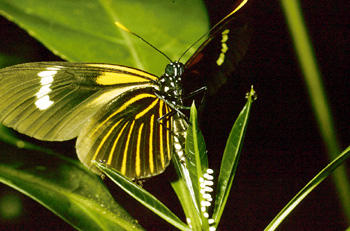Many different species may engage in Müllerian mimicry in any one local area, leading to mimicry "rings" consisting of tens of different species all looking alike. Mimicry appears to be among the most strongly selected of local ecological adaptations in Heliconius. Colour patterns are also used in mating decisions, and we have found evidence that mimicry may also be involved in speciation.
Another important source of ecological selection of interest to my group is adaptation to host plants. The caterpillars of Heliconius, as with many other insect species, feed narrowly on only a few plant species. Heliconius specialize on one plant family, the passion flowers (Passifloraceae). Other work done by the group has shown that host plant adaptation in the tortricid moth Zeiraphera diniana has led to the formation of strongly differentiated host races. As these forms can remain genetically distinct in spite of some gene flow, host race formation therefore acts as an early stage of speciation. Given that Heliconius species also hybridize, it is likely that similar effects are occurring in these butterflies.
Other important sources of selection in Heliconius are adult pollen feeding, pheromones and mating behaviour, cognitive abilities, and hybrid sterility. Heliconius is the only butterfly known to collect and use pollen as a source of amino acids for egg and spermatophore production, and is tightly coevolving with two genera of cucurbits that provide this pollen, Psigura and Gurania.
Heliconius are highly intelligent: each individual may navigate its home range of up to 4km2 of rainforest and light gaps in order to find larval foodplants or pollen donor plants. At dusk, individuals repeatedly return to gregarious roosts where they sleep overnight. In the erato-sara-sapho group of Heliconius, competition for females becomes so intense that adult males may sit on female pupae, and "rape" eclosing adults before they have even emerged from the chrysalis.
Although vision is involved in mate location and gregarious roosting, a still hardly studied mode of communication in butterflies involves a cocktail of male and female pheromones, including both aphrodisiac and anti-aphrodisiac scents. Some of these are encoded by families of olfactory and chemosensory genes known to be amplified in Heliconius.
Hybrid sterility, especially female sterility is a common finding in crosses between closely-related species of Heliconius. Because females in the Lepidoptera, including Heliconius, are the heterogametic sex (i.e. ZW sex chromsomes, as opposed to ZZ in males), this is an example of Haldane's Rule.
All of these traits are likely important in the diversification and speciation of Heliconius butterflies. A lot of this remains to be studied in Heliconius, and even more in the ithomiine butterflies. Future work of my group will address these questions in more detail.
 Heliconius pardalinus at Pongo de Cainarache, Peru. Photo © Fraser Simpson
Heliconius pardalinus at Pongo de Cainarache, Peru. Photo © Fraser Simpson Neruda aoede female laying eggs on ant-infested Dilkea (Passifloraceae). Pongo de Cainarache, Peru. Photo © James Mallet
Neruda aoede female laying eggs on ant-infested Dilkea (Passifloraceae). Pongo de Cainarache, Peru. Photo © James Mallet